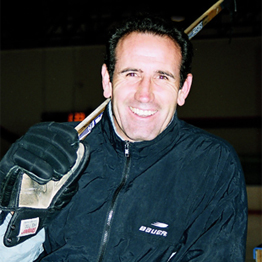Hockey players spend a lot of time on the ice gliding on two feet.
The gliding is interspersed with striding characteristics such as low, medium and high intensity skating and gliding and crossover turns.
Balance on one skate is not important for hockey players, because they rarely do this during a game.
A hockey player should maintain a position of bent ankles, knees, hips and trunk leaning forward.
| Time Skating Characteristics | % of Total Time on Ice | Frequency Skating Characteristics | % Total of Occurrences |
|---|---|---|---|
| Two Foot Glide | 40% | Left Crossover Turn | 20% |
| Cruise Strides | 16% | Gliding Left Turn | 17% |
| Medium Intensity Skating | 10% | Right Crossover Turn | 17% |
| Struggle for Puck or Position | 10% | Gliding Right Turn | 16% |
| Low Intensity Skating | 8% | Stop & Start | 10% |
| High Intnsity Skating | 5% | Forward -> Backward | 7.6% |
| Backward Skating | 5% | Backward -> Forward | 6% |
| Two Foot Stationary | 3% |
| 1. | Struggle for Puck/Position | 2 Seconds |
| 2. | 2 Foot Glide (Gliding Left Turn - Gliding Right Turn) | 2 Seconds |
| 3. | Cruise Stride (Left Crossover Turn) | 1 Second(s) |
| 4. | 2 Foot Glide (Gliding Left Turn) | 2.5 Second(s) |
| 5. | Cruise Stride (Left Crossover Turn) | 1 Second(s) |
| 6. | 2 Foot Glide (Gliding Left Turn) | 2.5 Second(s) |
| 7. | Cruise Strides (Right Crossover Turn) | 1 Second(s) |
| 8. | 2 Foot Glide (Gliding Left Turn - Gliding Right Turn) | 2 Second(s) |
| 9. | Struggle for Puck/Position | 2 Second(s) |
| 10. | Medium Intensity Skating (Left Crossover Turn) | 2.5 Second(s) |
| 11. | 2 Foot Glide (Gliding Right Turn) | 1.5 Second(s) |
| 12. | Medium Intensity Skating (Right Crossover Turn) | 1 Second(s) |
| 13. | 2 Foot Glide (Gliding Left Turn - Gliding Right Turn) | 1.5 Second(s) |
| 14. | Cruise Strides | 1.5 Second(s) |
| 15. | Low Intensity Skating (Left Crossover Turn) | 3.5 Second(s) |
| 16. | 2 Foot Glide (Gliding Left Turn) | 2.5 Second(s) |
Very little time is spent on one foot. During low intensity skating, only .44 sec. is spent on one foot, medium intensity skating = .32 sec. and high intensity skating = .26 (Marino, 1977). In one unpublished study (Bracko, 1990), out of 25 elite players (Canada Cup) analyzed, only one player spent more than one second on one foot.
Balance on one foot appears not to be an important performance skating factor for hockey players. A two foot glide position is an important performance characteristic and is the basis from which all other skating characteristics are derived.
All skating characteristics evolve from a two foot glide position. The ability to move into other skating characteristics from a two foot glide position is important for hockey players as the nature of the game is stride – glide – stride – glide (Bracko, 1998).
Performance enhancement programs should emulate game performance skating. Game performance skating is characterized by : gliding – striding – turning – gliding – striding – turning, etc.
There is a lot of skating and maneuvering while under the influence of stick and/or body contact which increases energy expenditure and may cause fatigue more so than simple high intensity skating (NHL forwards engage in high intensity skating 5% of the time on the ice.)

Hockey Institute – All Rights Reserved – Calgary Web Design by Blue Ocean